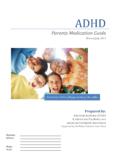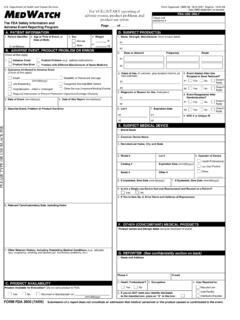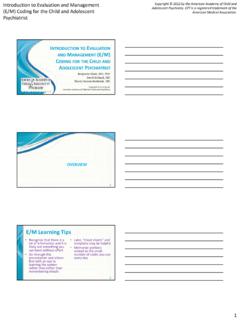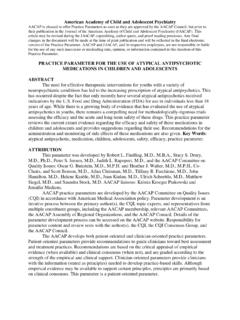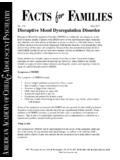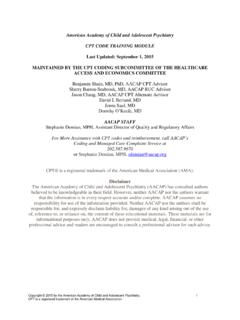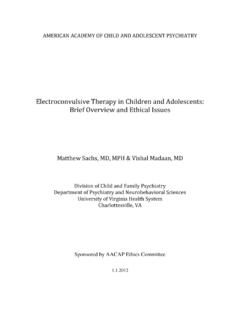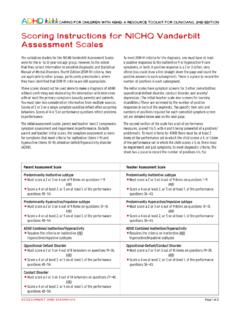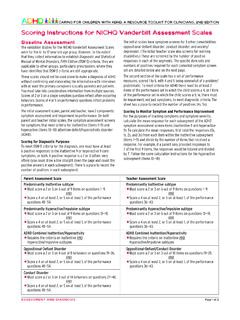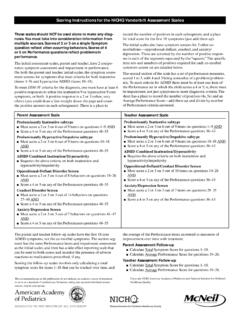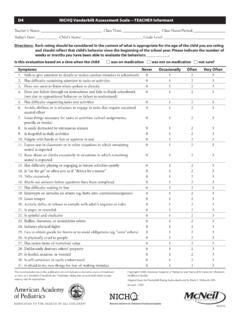Transcription of NICHQ Vanderbilt Assessment Follow-up—TEACHER …
1 D6 NICHQ Vanderbilt Assessment follow -up TEACHER Informant Teacher's Name: _____ Class Time: _____ Class Name/Period: _____. Today's Date: _____ Child's Name: _____ Grade Level: _____. Directions: Each rating should be considered in the context of what is appropriate for the age of the child you are rating and should reflect that child's behavior since the last Assessment scale was filled out. Please indicate the number of weeks or months you have been able to evaluate the behaviors: _____. Is this evaluation based on a time when the child was on medication was not on medication not sure? Symptoms Never Occasionally Often Very Often 1. Does not pay attention to details or makes careless mistakes with, 0 1 2 3. for example, homework 2. Has difficulty keeping attention to what needs to be done 0 1 2 3.
2 3. Does not seem to listen when spoken to directly 0 1 2 3. 4. Does not follow through when given directions and fails to finish 0 1 2 3. activities (not due to refusal or failure to understand). 5. Has difficulty organizing tasks and activities 0 1 2 3. 6. Avoids, dislikes, or does not want to start tasks that require ongoing 0 1 2 3. mental effort 7. Loses things necessary for tasks or activities (toys, assignments, 0 1 2 3. pencils, or books). 8. Is easily distracted by noises or other stimuli 0 1 2 3. 9. Is forgetful in daily activities 0 1 2 3. 10. Fidgets with hands or feet or squirms in seat 0 1 2 3. 11. Leaves seat when remaining seated is expected 0 1 2 3. 12. Runs about or climbs too much when remaining seated is expected 0 1 2 3. 13. Has difficulty playing or beginning quiet play activities 0 1 2 3.
3 14. Is on the go or often acts as if driven by a motor 0 1 2 3. 15. Talks too much 0 1 2 3. 16. Blurts out answers before questions have been completed 0 1 2 3. 17. Has difficulty waiting his or her turn 0 1 2 3. 18. Interrupts or intrudes in on others' conversations and/or activities 0 1 2 3. Somewhat Above of a Performance Excellent Average Average Problem Problematic 19. Reading 1 2 3 4 5. 20. Mathematics 1 2 3 4 5. 21. Written expression 1 2 3 4 5. 22. Relationship with peers 1 2 3 4 5. 23. Following direction 1 2 3 4 5. 24. Disrupting class 1 2 3 4 5. 25. Assignment completion 1 2 3 4 5. 26. Organizational skills 1 2 3 4 5. The recommendations in this publication do not indicate an exclusive course of treatment Copyright 2002 American Academy of Pediatrics and National Initiative for Children's or serve as a standard of medical care.
4 Variations, taking into account individual circum- Healthcare Quality stances, may be appropriate. Adapted from the Vanderbilt Rating Scales developed by Mark L. Wolraich, MD. Revised - 0303. HE0353. D6 NICHQ Vanderbilt Assessment follow -up TEACHER Informant, continued Teacher's Name: _____ Class Time: _____ Class Name/Period: _____. Today's Date: _____ Child's Name: _____ Grade Level: _____. Side Effects: Has the child experienced any of the following side Are these side effects currently a problem? effects or problems in the past week? None Mild Moderate Severe Headache Stomachache Change of appetite explain below Trouble sleeping Irritability in the late morning, late afternoon, or evening explain below Socially withdrawn decreased interaction with others Extreme sadness or unusual crying Dull, tired, listless behavior Tremors/feeling shaky Repetitive movements, tics, jerking, twitching, eye blinking explain below Picking at skin or fingers, nail biting, lip or cheek chewing explain below Sees or hears things that aren't there Explain/Comments: For Office Use Only Total Symptom Score for questions 1 18: _____.
5 Average Performance Score: _____. Please return this form to: _____. Mailing address: _____. _____. Fax number: _____. Adapted from the Pittsburgh side effects scale, developed by William E. Pelham, Jr, PhD. 11-22/rev0303. Scoring Instructions for the NICHQ Vanderbilt Assessment Scales These scales should NOT be used alone to make any diag- record the number of positives in each subsegment, and a place nosis. You must take into consideration information from for total score for the first 18 symptoms (just add them up). multiple sources. Scores of 2 or 3 on a single Symptom The initial scales also have symptom screens for 3 other co- question reflect often-occurring behaviors. Scores of 4 morbidities oppositional-defiant, conduct, and anxiety/. or 5 on Performance questions reflect problems in depression.
6 These are screened by the number of positive respon- performance. ses in each of the segments separated by the squares. The specific The initial Assessment scales, parent and teacher, have 2 compo- item sets and numbers of positives required for each co-morbid nents: symptom Assessment and impairment in performance. symptom screen set are detailed below. On both the parent and teacher initial scales, the symptom assess- The second section of the scale has a set of performance measures, ment screens for symptoms that meet criteria for both inattentive scored 1 to 5, with 4 and 5 being somewhat of a problem/problem- (items 1 9) and hyperactive ADHD (items 10 18). atic. To meet criteria for ADHD there must be at least one item of To meet DSM-IV criteria for the diagnosis, one must have at least 6 the Performance set in which the child scores a 4 or 5; ie, there must positive responses to either the inattentive 9 or hyperactive 9 core be impairment, not just symptoms to meet diagnostic criteria.
7 The symptoms, or both. A positive response is a 2 or 3 (often, very sheet has a place to record the number of positives (4s, 5s) and an often) (you could draw a line straight down the page and count Average Performance Score add them up and divide by number the positive answers in each subsegment). There is a place to of Performance criteria answered. Parent Assessment Scale Teacher Assessment Scale Predominantly Inattentive subtype Predominantly Inattentive subtype Must score a 2 or 3 on 6 out of 9 items on questions 1 9 AND Must score a 2 or 3 on 6 out of 9 items on questions 1 9 AND. Score a 4 or 5 on any of the Performance questions 48 55 Score a 4 or 5 on any of the Performance questions 36 43. Predominantly Hyperactive/Impulsive subtype Predominantly Hyperactive/Impulsive subtype Must score a 2 or 3 on 6 out of 9 items on questions 10 18 Must score a 2 or 3 on 6 out of 9 items on questions 10 18 AND.
8 AND Score a 4 or 5 on any of the Performance questions 36 43. Score a 4 or 5 on any of the Performance questions 48 55 ADHD Combined Inattention/Hyperactivity ADHD Combined Inattention/Hyperactivity Requires the above criteria on both inattention and Requires the above criteria on both inattention and hyperactivity/impulsivity hyperactivity/impulsivity Oppositional-Defiant/Conduct Disorder Screen Oppositional-Defiant Disorder Screen Must score a 2 or 3 on 3 out of 10 items on questions 19 28. Must score a 2 or 3 on 4 out of 8 behaviors on questions 19 26 AND. AND Score a 4 or 5 on any of the Performance questions 36 43. Score a 4 or 5 on any of the Performance questions 48 55 Anxiety/Depression Screen Conduct Disorder Screen Must score a 2 or 3 on 3 out of 7 items on questions 29 35.
9 Must score a 2 or 3 on 3 out of 14 behaviors on questions AND. 27 40 AND Score a 4 or 5 on any of the Performance questions 36 43. Score a 4 or 5 on any of the Performance questions 48 55. Anxiety/Depression Screen Must score a 2 or 3 on 3 out of 7 behaviors on questions 41 47. AND. Score a 4 or 5 on any of the Performance questions 48 55. The parent and teacher follow -up scales have the first 18 core the average of the Performance items answered as measures of ADHD symptoms, not the co-morbid symptoms. The section seg- improvement over time with treatment. ment has the same Performance items and impairment Assessment Parent Assessment follow -up as the initial scales, and then has a side-effect reporting scale that Calculate Total Symptom Score for questions 1 18.
10 Can be used to both assess and monitor the presence of adverse Calculate Average Performance Score for questions 19 26. reactions to medications prescribed, if any. Teacher Assessment follow -up Scoring the follow -up scales involves only calculating a total Calculate Total Symptom Score for questions 1 18. symptom score for items 1 18 that can be tracked over time, and Calculate Average Performance Score for questions 19 26. The recommendations in this publication do not indicate an exclusive course of treatment Copyright 2002 American Academy of Pediatrics and National Initiative for Children's or serve as a standard of medical care. Variations, taking into account individual circum- Healthcare Quality stances, may be appropriate.
